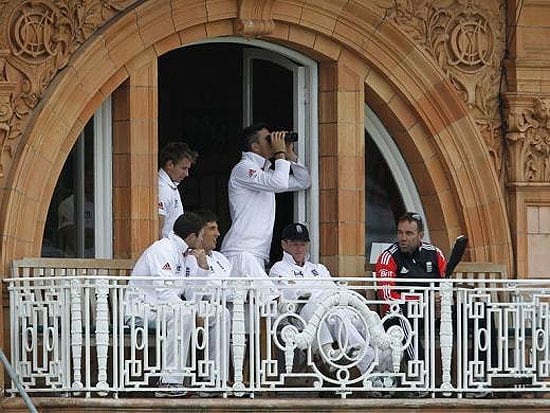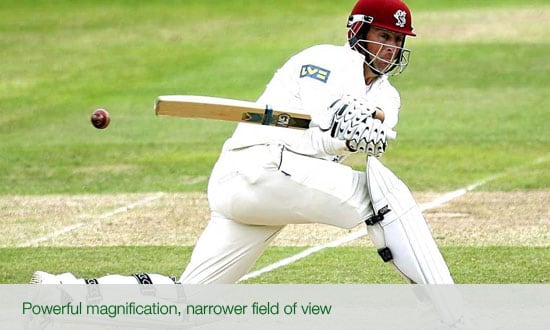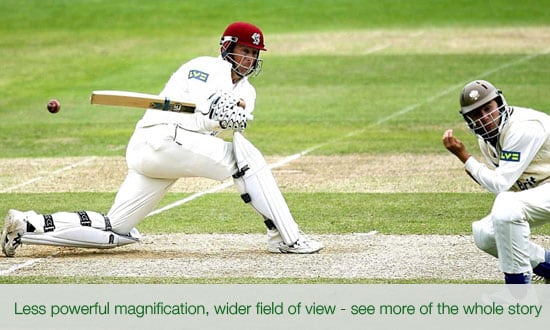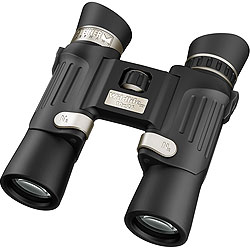

Binocular Reviews Home > Binoculars by Use > Binoculars for Watching Sports > Best Cricket Binoculars
Eng vs SA - Who in the England Dressing room is using Binoculars to watch the cricket? Know the answer? Please comment below.
>> Skip the blurb, show me the best cricket binoculars
It does not matter if you are watching a test match between the old rivals, England and Australia, a limited overs one day international, county cricket game, a Twenty20 slog-fest or even just the local club game on the village green, a good pair of binoculars really will add to your enjoyment of the game and I highly recommend taking a pair with you.
When I lived in Zimbabwe and in the UK, I watched and even played quite a bit of cricket and would almost always take my binoculars with me. I find that I don't watch cricket with binoculars over really long periods of time as you tend to miss out on the overall experience of being at the ground, but they are ideal for getting a closer look at the batsman or bowler for a few balls at a time.
In between overs, binoculars are also perfect for taking a look at which fielders are in the slips, who is way down at fine leg or even checking out the scoreboard at the other side of the ground. Binoculars are also great for crowd watching in between overs, during innings breaks, or when the play has been stopped for rain or bad light.

Really good cricketing binoculars will in many cases be quite similar to that of most good general sports binoculars and bird watching binoculars, but with a few small differences. Take a look below as I go over some of the most important features to look out for when choosing your binoculars for cricket:
How much you should spend on your optics will largely be down to your circumstances, how often you plan to use them and just how highly you rate the importance of quality versus price. But if you were to take any advice from this page or indeed this website, then please don't opt for the cheapest binoculars out there. Very cheap binoculars are often no better than toys and in some cases you can actually get children's binoculars that will perform better! The worst binoculars will also most probably put you off using them, not last very long and the poor quality image will in some cases mean that you will be better off not using them at all.
However I am not suggesting that you have to spend a fortune on your optics either. Whilst it is true that the very best binoculars are also quite often some of the most expensive, there are also some really very good pairs of out there these days that won't cost you much more than a single ticket to a test match, yet you can use them for many years to come, safe in the knowledge that the view you get through them is of a very high quality. To give you an idea, take a look at some of the Best Value For Money Binoculars that I have reviewed in different price categories, or take a look at my winner for the overall Best Value For Money Binocular Award.
Without taking the time to consider all the pros and cons, I think most people will come to the conclusion that you need a really compact, lightweight pair making them very easy to carry to the game, which may indeed be the case for some people. But compacts do have their drawbacks and just maybe a mid or even full sized pair will actually be a better option for your cricket binoculars.
I say this because unlike activities such as birding or general wildlife observation, where you often have to carry your binoculars around in the field, with cricket, once you get to the ground, you'll most probably be seated most of the time. So as long as your optics are small and light enough to be stowed away in your bag (along with your sandwiches, sunscreen, hat and portable radio!), having a very compact pair of binos is probably not that critical to everyone and the benefits that mid-sized or even full sized ones have over compacts may be well worth the relatively small amount of extra weight and size:
There main advantages that larger binoculars have over compacts especially in relation to watching cricket include:
If you do decide to go for a full sized binocular, it does however make sense to choose a pair that is small and lightweight when compared to others in their size class as some of the smallest, lightest ones really don't feel that much bigger than many mid-sized binoculars and yet you get all the benefits of having much larger objective lenses.
To illustrate my point, take a look at the size and weight specifications of the following full-sized binoculars:
| Vanguard 10x42 Spirit ED | Kowa 10x42 SV | Steiner 10x42 SkyHawk | Minox 10x42 BV | Swarovski 10x42 EL | Barr & Stroud 8x42 Savannah ED | |
| Weight: | 22.6ozs (641g) | 23.6oz (670g) | 25.4oz (720g) | 27.5oz (780g) | 27.5ozs (780g) | 28.9ozs (819g) |
| Length: | 5.7in (14.5cm) | 6.8in (17.2cm) | 5.9in (15.1cm) | 5.5in (14cm) | 6.2in (15.7cm) | 5.9in (15cm) |
| Width: | 4.9in (12.4cm) | 5.0in (12.8cm) | 4.9in (12.5cm) | 5in (12.7cm) | 4.8in (12.2cm) | 5.1in (13cm) |
So to sum up:
The is no right or wrong choice and what size you do get for your cricket binoculars will depend on your personal preferences:
The whole point of a taking a pair of binoculars to watch cricket is to get closer to the action, so most people come to the misguided conclusion that the more powerful the magnification the better the binocular. This is definitely not true as high powered binoculars have a number of drawbacks and three main ones that are related to watching cricket:
So you have to make a compromise between getting close enough to the action to really see what is going on in great detail, but not so close that it makes actually means you are missing out on the whole story!
Obviously how far away you are from what you want to look at will also play an important part in choosing the right magnification, but in my experience magnifications of about 8x to 10x is about right for most cricket grounds.

The field of view (FOV) of a pair of binoculars is basically the width of the image that you can see through the binoculars. For activities like bird watching, where you are observing small erratic and fast moving objects, a wide FOV is very important as it helps you to quickly locate the bird as you have more chance of it instantly being in your view. For cricket where the "objects" you are looking at are large, relatively slow mammals dressed in white making them stand out, the FOV is really not that critical.
But having said that, a wider field of view does have the advantage in that it enables you to catch as much of the action all at once without having to move the binoculars about, so ideally you'll want is a pair of binoculars with a reasonably wide FOV within your chosen magnification. Remember: In most cases the more powerful the magnification, the smaller your field of view will be.
A binoculars FOV is usually expressed in feet at a distance of 1,000 yards, but increasingly common is in meters at 1,000 meters or it is sometimes described as an angle. I would say that a FOV of around 315ft at 1,000 yards (105m at 1,000 meters / 6.0° ) is fine, but in general the wider the better (as long as the image remains sharp right to the edges), so if you are undecided between two models, check which has the widest FOV as this may help you to make your decision.

In general, you will come across two main designs/styles of binocular depending on the type of prism they use: the Roof Prism or the Porro Prism. Both have their own advantages over each other and so as with many things in optics there is no best option or right answer and the choice you make will be down to your own personal preferences:
The amount of eye-relief the binocular has will be very important to those who use glasses and want to keep them on whilst watching cricket through their binoculars. Eye Relief is basically the distance from the ocular lenses or the last surface of an eyepiece at which the eye can obtain the full field of view. Eyecups on the binoculars ensure that your eyes will be at the correct distance for this to happen, but if you wear glasses, you can't get your eyes as close to the lenses as those without glasses, so you need to adjust the eyecups to ensure that even with your glasses on your eyes are the correct distance from the ocular lenses. Binoculars with a longer eye relief are ideal for those who wear glasses as they basically project the image further beyond the ocular lens, giving you plenty of room to play with. So if you wear glasses, you should be looking for an eye relief of at least 15mm, to see the full image full image. The down side to long eye relief is that it usually reduces the field of view.
Below you will see that I have listed a few of the best binocular for watching cricket that I have reviewed in the three main size categories:
Or you can take a look at All Binoculars ideal for Sporting Events, including Cricket that I have so far reviewed.
|
With high quality ED Glass lenses, Phase Coated Bak-4 Prisms and a very wide field of view these make an excellent choice as a birding, wildlife observation and general use binocular.
Price: (3/6) Mid Priced Binoculars | |||||||||||||||
|
|
Mid-range binoculars that to my mind offer a level of quality and performance that easily surpasses their price tag. Highlights include a Magnesium Housing, ED Glass Elements in the Lenses, Phase Corrected BaK-4 prisms, 18mm of eye-relief and a close focus distance of less than 2 meters. Price: (3/6) Mid Priced Binoculars | |||||||||||||||
|
|
The MINOX BV 8x42 BR is a great binocular for all purpose viewing that will please the cost-conscious birder or nature observer. The BV 8x42 BR is has a nice wide field of view and magnification making them easy to follow wildlife on the move. These binoculars make an ideal choice for travelling including safari holidays and birdwatching.
Price: (3/6) Mid Priced Binoculars |
|
Updated, the new mid priced 8x42 Eagle Optics Denali binocular comes with upgraded coatings and a higher quality prism. You also get a closer minimum focus and even more eye-relief, making them an ideal all-round instrument and perfect for the eye-glass wearer. Price: (3/6) Mid Priced Binoculars | |||||||||||||||
|
|
Mid priced Helios binoculars with a host of features that you would only expect to see on high end, far more expensive instruments. This includes a a magnesium chassis, fully multi-coated optics and phase corrected BaK-4 prisms that have been dielectrically coated for the highest levels of light transmission. Price: (3/6) Mid Priced Binoculars | |||||||||||||||
|
Below are some of the best Mid Size binoculars for cricket, sorted by size, that I have so far reviewed:
|
Nikon & SHE Outdoor Apparel have come together and designed a pair of binoculars for women ideal for most outdoor adventures including especially safaris. The Nikon SHE Safari Monarch is not only good looking, but include high spec quality optics that produce an excellent quality image.
Price: (3/6) Mid Priced Binoculars | |
|
|
Mid-sized, mid-priced Hawke binoculars that impress in almost single every area. A fully fog and waterproof magnesium housing protects high quality and fully multi-coated optics with highlights that include ED glass lenses, BaK-4 roof prisms that have been phase corrected. The result is a high quality and bright image that has a wide field of view, good close focus and delivers plenty of eye-relief. Price: (3/6) Mid Priced Binoculars | |||||||||||||||
|
|
Top of the line mid-sized binoculars from Celestron with that feature a lightweight open bridge magnesium body that protects high end optical components. These include fully multi-coated lenses, with ED glass elements and Bak-4 roof prisms with phase correction and very highly reflective dielectric mirror coatings that really do help produce a superior view.
Price: (4/6) Mid-High Value Binoculars | |||||||||||||||
|
Below are some of the best compact binoculars for cricket, sorted by size, that I have so far reviewed:
|
The Eschenbach club-W sets a new standard in sophisticated elegance with uncompromising optical quality, easy on the eye and designed with women in mind. These stylish binoculars won't look out of place at Ascot, Wimbledon or out on a country walk. Housed in the stunning mother-of-pearl effect body are state of the art optics guaranteed to please the most discerning user.
Price: (4/6) Mid-High Value Binoculars |
|
Low costing compact binocular from Levenhuk that comes with a number of higher end features including a water and fog proof shell that protects fully multi-coated optics within. Highlights also include a very wide field of view and a close minimum focusing distance. Price: (2/6) Low Cost Binoculars | |||||||||||||||
|
|
The 10x25 Nikon Ecobins Binoculars combine a tough, lightweight, fully waterproof body with some great optics that include features like aspherical eyepiece lenses to decrease distortion. Combine this with the knowledge that they have been manufactured with the environment in mind means you can take them almost anywhere and feel good in the knowledge that you are not harming the very thing you are looking at through them.
Price: (3/6) Mid Priced Binoculars | |
|
View >> All General Sporting Binoculars that will also be ideal for Cricket
 Related Articles & Further Reading
Related Articles & Further Reading